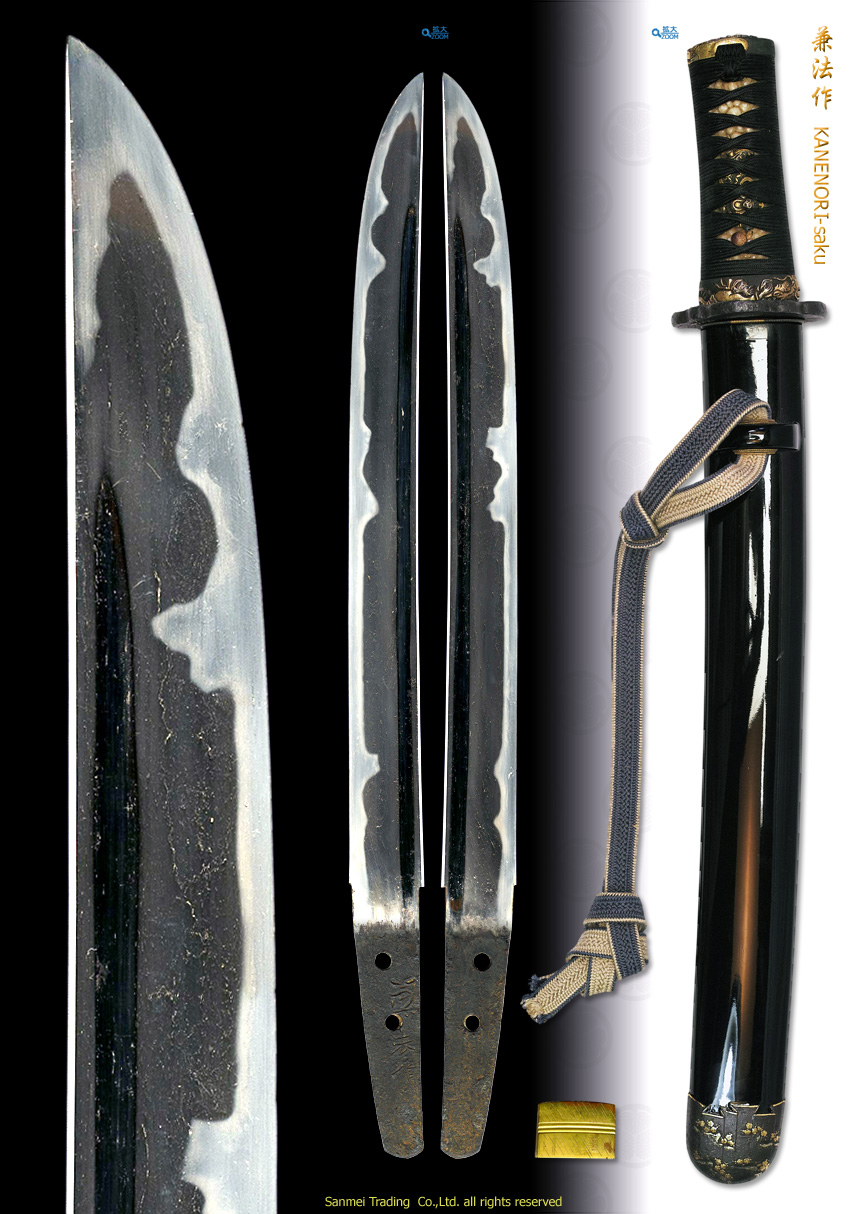with) Black Roiro lacquered scabbard Tanto Koshirae
Length of cutting edge 27.0cm Curvature 0.1cm Width of base 24.9mm Thickness of base 5.4mm
Kitae(forging pattern) : The entire steel gives off bluish tendency. Kitae is conspicuous Itame hada generally with the indication of streaming ware. Striking Masame straight ware appears mostly along Hamon boundary line. Sparkling frosty Ji-nie is distributed or concentrates in certain areas over the Hira-ji surface so called Shirake-Utsuri and Black Gleaming Lines of Chikei layers, that comes of steel with a different, higher carbon content, appears and glows as Kin-suji thick line of Nie or Sunagashi short lines into tempered quenching area.
Hamon(tempering pattern) : Hamon state is "Ko-nie-deki" that is a bit on stronger side, Hamon of both side are matching well, undulating Notare with large of Choji-midare and combined Gunome or pointed Togari-ha indication which varies in height and shape. Upper the blade it becomes lively with Soushu-technique - stronger the Nie and deeper the Nioi to form isolated temper of Tobiyaki activities - flamboyant scene.
Sparkling martensite particles of Nie accumulates deeply at the ends of valley where works with Sunagashi and Kinsen activity and the interior of temper is filled with frosty sparkling Nioi with rich Sunagashi where is sparkling brightly.
Boshi (tip): Undulating Notare, small circle turns back to form "Jizo-style" as a side view of Jizou stone stature.
Nakago(tang) : The tang is UBU original. Two Mekugi-ana retaining holes. "Higaki" crossing filemarks. Shallow Kurijiri of double bevelled heel. The entire Nakago preserves good taste of patina from 16th C. The large and deeply chiseled three character KANENORI-saku 兼法作 is unique way to one of KANENORI 兼法 during Tensho period.
The smith KANENORI 兼法 is said as a source origins to Mino-Senjuin tradition, who belonged to Nara-ha school during Muromachi period. KANENORI worked both in Uruma town (now Unuma, Kagamigahara, Gifu) and Seki city as well. According to Nihonto Meikan, the oldest extant work with the date of year is dated in Meiou 8 (1499) as a practical founder then ranges to Bunroku 4 (1595). There would exist at least 5 generations of active KANENORIs during it's history of 100 years.
Most of extant KANENORI works are recognized from Tenbun - Tensho era (1532-91).The most major characteristic of this heroic Tanto is it's extravagant Hamon of flamboyant pattern of temper from Soushu tradition that suit Samurai taste during Azuchi-Momoyama period. Also Inscription signature of this KANENORI during Tensho era shows a distinguishing trait from the others.
The entire blade still remains original condition for the age of 450 years. Among similar works, this blade is a delight and it's workmanship is hidden with an awe-inspiring power from the Warning States period.
This delight Tanto was supposed to supplement what large Katana couldn't provide during critical battle now presents you to come with an original decorative Tanto Koshirae from Edo period.
with) Black Ro-iro lacquered scabbard Tanto Koshirae(click HERE for entire Koshirae / HERE for each fitting)
- Fuchi/Kashira : Taoist/Dragon design. Shakudo Nanako-ji surface, Takabori carving Gold/Silver Iroe inlay, unsigned
- Kozuka : Dragon Wave design, Iron ground, Sukibori carving, Gold Inlay, unsigned
- Kojiri : Sakura design, Iron ground, Gold Nunome-style inlay, unsigned
- Tsuba : Irregular shape, Iron ground, Hammered surface, Crest/Plum UME design, Unsigned
- Tsuka : White layskin, Black silk cord lozenge warp
Due to old polish status, there are some insignificant tip-off along upper Fukura area and slight scratches on Hiraji-surface. Next chance of skilled polish will blow those wares away entirely.
reference data:
Suzuki Takuo/Sugiura Yoshiyuki, Muromachi-ki Mino-toko-no Kenkyu, Ribun Shuppan, 2006
Tokuno Kazuo, Mino-toko Taikan, Otsuka Kogeisha, 1976
Honma Kunzan/Ishii Masakuni, Nihonto meikan, Yuzankaku 1976




